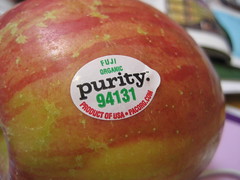![]() Photo credit: {Guerrilla Futures | Jason Tester}
Photo credit: {Guerrilla Futures | Jason Tester}
What are genetically modified foods?
Biotechnology covers a broad range of technological “advancements†in food. These include the production of herbicides and pesticides, the use of antibiotics in dairy and meat, and of course, genetically modified foods (Otero, 2008). Genetically modified food refers to food that has had its genetic structure altered in some way, such as by mixing genes of different organisms. Generally, this has been done to make a crop more efficient to produce, export and sell (Bakshi, 2003). Examples include making crops resistant to certain herbicides or pesticides, making food tougher and firmer to last during international shipping, and making crops that grow faster (Bakshi, 2003).
What’s wrong with GMOs?
Genetically modified food is shown to be very harmful. Increased serious food allergies (such as for soybeans and corn), heavy metal contamination, and antibiotic resistance are several examples of adverse health effects. Dr. Arpad Pusztai’s famous study determined that GM foods were toxic to mammals (see my article on the Dangers of Genetically Modified Foods). Mice that were fed a diet of GM foods became very ill (Bakshi, 2003). Interestingly, Pusztai’s research lost its funding from the British government (Bakshi, 2003). As well, GM foods are speculated to have less nutritional value than conventional, natural crops of the same kind (Bakshi, 2003). Lastly, most research that determined GM foods to be safe has been focused on one particular chemical at a time. That is, the combination of different chemicals (as they would appear in food) has mostly gone unexamined (Bakshi, 2003).
These are the health effects of biotechnology, although they have many more problems, including the loss of biodiversity, and patents on plants and animals. As Greenpeace states, “Life is not a commodity†(http://www.greenpeace.org/canada/en/campaigns/ge/). Additionally, the infamous terminator seeds are plants that are bioengineered to produce sterile seeds. This means that farmers cannot use the seeds to plant future crops in the upcoming years; new seeds must be purchased every year, leaving farmers dependent on biotechnology giants like Monsanto. Today, biotechnology corporations are some of the most powerful corporations in the world.
How to avoid GM foods:
The problem (as most of us know already) is that in North America, GMO foods are not labeled as genetically modified, as they are in Europe and other parts of the world. How, then, do we say “no†to GMO?
Look for Non-GMO Product Certifications
Since North American governments have failed to assure consumers about the safety of their food by labeling genetically modified products, individuals and organizations have taken it upon themselves to do this.
The North American non-profit organization Non-GMO Project (http://www.nongmoproject.org/) has made a commitment to identify and locate products and companies that do not use any genetically modified ingredients. These include Nature’s Path Foods, Barbara’s Bakery, Choice Teas and Tofurky (meat alternatives). However, as mentioned, not all non-organic food is genetically modified. Non-organic companies that are still non-genetically modified include Kettle Chips, Silk (soy beverages), and Bragg’s soy sauce.
The organization is relatively new, so the Non-GMO Project assures us that the certification will be available sometime this Fall. Better yet, the Project has named October as GMO-free month! In the meantime, check out their website and sign the consumer pledge (http://www.nongmoproject.org/consumers/consumer-pledge/) showing that you support their work and will purchase non-GMO products.
Look for Certified Organic
Generally, a good indicator of a GMO-free product is an organic certification. All products that are certified organic (meaning that it obeys the guidelines of a third party certifying body) must be non-genetically modified. Even this, however, can be difficult with multi-ingredient products. Tracking the sourcing of every ingredient can be tricky.
Look for common GM ingredients
When you’re in doubt, the most common genetically modified ingredients include corn, soy and canola. However, the situation becomes more difficult when these ingredients are hidden in other ingredients. Genetically modified corn, for instance, can be found in corn starch, high fructose corn syrup, and even maltodextrin. Because of these complexities, “it is estimated that GMOs are now present in more than 80% of packaged products in the average U.S. or Canadian grocery store†(source: http://www.nongmoproject.org/consumers/about-gmos/).
Take action
Greenpeace’s website contains some excellent resources for consumers to take action against genetically modified food. Locate it here: http://www.greenpeace.org/canada/en/campaigns/ge/Get-involved/ and send letters to political representatives explaining your concerns and urging them to take action.
Contact the Company
A possible way to find out if your favourite food contains genetically modified ingredients is by contacting the company directly. The only problem with this is that the one who answers the emails may not be the one who sees the food production firsthand.
From my own experience, I have received several responses that explain that it is difficult to track the production of the product, and therefore they don’t know for sure if biotechnology has been used. Is this an excuse to cover up known genetically modified ingredients? Is it a real example of how, when a company gets so large and decentralized, they no longer have full knowledge of the production process? Either way, it’s not ideal for the consumer.  Â
Your best bet? Buy certified organic, buy products labeled as non-genetically modified, support genetically-modified labeling initiatives by donating, and contact your political representatives to send them a message.

Recommended Comments
Join the conversation
You can post now and register later. If you have an account, sign in now to post with your account.